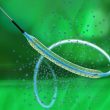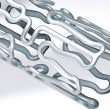Between 10% and 15% of patients admitted with ST-segment elevation myocardial infarction present concurrent coronary chronic total occlusion (CTO) in a non-infarct-related artery, which is associated with increased morbidity and mortality. The EXPLORE (Evaluating Xience and Left Ventricular Function in Percutaneous Coronary Intervention on Occlusions After ST-Elevation Myocardial Infarction) trial evaluated whether patients admitted...
DAPT after PCI with EES: 6 or 12 Months?
Original Title: 6-Month versus 12-Month Dual-Antiplatelet Therapy Following Long Everolimus-Eluting Stent Implantation. The IVUS-XPL Randomized Clinical Trial. Reference: Hong et al. JACC Cardiovasc Interv. 2016 May 11. [Epub ahead of print] Courtesy of Dr. Brian Nazareth Donato. This publication stems from the IVUS-XPL published by JAMA in November 2015. This study presents outcomes on the...
SORT OUT IV at 5 years: second generation DES efficacy confirmed
Original Title: Safety and efficacy of everolimus-versus sirolimus-eluting stents: 5-Year results from SORT OUT IV. Reference: Jensen LO et al. J Am Coll Cardiol. 2016;67:751-762. Reassuring long term outcomes from SORT OUT IV confirm the safety and efficacy of second generation everolimus eluting stents (EES) over first generation DES. The difference at 5-year follow up...
Drug eluting balloon vs. second generation DES for restenotic lesions in bifurcations
Original Title: Drug-eluting balloon versus second-generation drug-eluting stent for the treatment of restenotic lesions involving coronary bifurcations. Reference: Toru Naganuma et al. EuroIntervention 2016;11:989-995 Courtesy of del Dr. Santiago F. Coroleu. PCI involving in-stent restenosis (ISR), especially in coronary bifurcations, is associated with high rates of recurrent restenosis and the need for new revascularization. Although drug...
ABSORB III: Everolimus Eluting Bioresorbable Scaffolds for Coronary Artery Disease
Original Title: Everolimus-Eluting Bioresorbable Scaffolds for Coronary Artery Disease. Reference: Stone, M.D. for the ABSORB III Investigators. N Engl J Med 2015;373:1905-1915. The ABSORB III is part of a series of randomized studies that test bioresorbable scaffolds in the clinical practice (ABSORB II, EVERBIO II, ABSORB Japan, and ABSORB IV). 2008 patients were randomized; 60% had...
IVUS-XPL: IVUS superior to angiography for guiding DES implantation in long lesions
Original Title: Effect of intravascular ultrasound-guided vs angiography-guided everolimus-eluting stent implantation: the IVUS-XPL randomized clinical trial. Presenter: Hong S-J. Patients with long coronary lesions have better clinical results after a year of second generation DES implantation when interventions are guided by IVUS, instead of angiography. The benefit was attributed to a lower revascularization rate of ischemia...
ABSORB China: Constatação de não inferioridade em estudo prospectivo randomizado de scaffold bioabsorvível com eluição de everolimus versus stent metálico eluido em everolimus em pacientes com doença arterial coronária
Fundamentos: O stent bioabsorvível com eluição de everolimus (BVS) foi projetado para atingir resultados comparáveis ​​aos stents metálicos com eluição de drogas (DES) em 1 ano, com melhores resultados a longo prazo. Ainda não foi estabelecido se os resultados clínicos e angiográficos em 1 ano do BVS são não-inferiores aos resultados atuais dos DES ....
Stent eluidor de sirolimus com polímero absorvível apresenta superioridade em relação a stent eluidor de everolimus com polímero durável
Fundamentos: Ainda há controvérsias em relação à superioridade dos polímeros absorvíveis em relação aos polímeros duráveis, e vários estudos com a comparação entre esses dois modelos vem sendo realizados. Objetivos: Comparar os desfechos clínicos em 3 anos entre o stent eluidor de sirulimus com polímero absorvível MiStent® (APSES) com um stent eluidor de everolimus com...
ITALIC PLUS: 6 months of double antiaggregation for no less than 24 months
Article This multicenter study included patients receiving the second generation stent XIENCE V (Abbott Vascular) randomized to 6 and 24 months of double antiaggregation therapy after confirming non-resistance to aspirin. Primary end point was a combination of death, infarction, emergency revascularization of target vessel, stroke and major bleeding. The study saw early termination due to...
COMPARE II: A randomized prospective study compared the permanent polymer everolimus-eluting stent with a biodegradable polymer biolimus coated stent.
Randomized prospective study comparing the everolimus-eluting polymer-coated stent versus a biodegradable polymer with biolimus coated stent. While the use of first generation DES effectively reduces restenosis and reintervention rates, several meta-analyzes have shown a higher rate of late events of thrombotic origin associated with inflammatory phenomena and delayed reendothelialization at the site of implantation compared...









